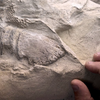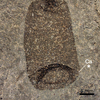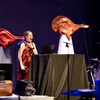A Dinosaur with Golden Bones?

An artistic rendering of an Iguanodon.
If you’ve ever seen a dinosaur’s skeleton in a natural history museum, what you’ve seen is a stone replacement of the original dinosaur’s bones. Sometimes, a mineral will leach into the bones' pores during permineralization, preserving the bones and infusing them with outside elements, as in the Bernissart Iguanodons. These impressive specimens have been pyritized, sparkling as though they're made of gold.
In 1878, Belgian coal miners in Sainte-Barbe found a massive pocket of clay hundreds of meters below ground. Inside the pocket, what the miners thought was gold wedged in tree trunks was really thirty intact Iguanodons, all of them pyritized.
Pyrite, better known as fool’s gold, is an iron-sulfur compound that while worth little is a beautiful mineral. To the miners, it looked as though they had come across thirty Iguanodons with golden bones. They formed when algae in swampland reacted with iron sediment, creating pyrite that poured into the remains of the dinosaurs.
The thirty Iguanodons (and a host of other discovered creatures) were carted off to the Belgian Royal Museum of Natural History where they were studied and later set up for display. Originally the specimens were arranged in a bipedal position, in what was then believed to be the animals’ natural walking posture. Later in 1980 on these same fossils it was determined that Iguanodons moved about on four legs. They can still be seen on display today, though the remains are too fragile to rearrange into their correct stance.
Want to learn more about the Iguanodon and even get a pyritized piece of your own? Check out our Pyritized Iguanodon specimen in the shop!
Featured Product
Joe Frazier Boxing Glove
Cool Things!

Is “Paul is Dead” Dead?: Unpacking One Of Pop Culture’s Most Enduring Conspiracy Theories

Scientists Discover Hooves and Skin in Preserved Dinosaur "Mummies!"
A dinosaur discovery just in time for Halloween! In a new analysis of a group of fossils from Wyoming, Scientists have determined this group of fossils are dinosaur “mummies,” with preserved skin and even hooves.

Scientists Record a Bat Catching Birds Mid-Flight!
Bats, birds, screeches, oh my! In a reverse-Hitchcock twist, a new study reveals that a species of European bat catches and eats birds mid-flight.
Specimen Deep Dives

The House that Ruth Built: The Story of the Old Yankee Stadium

The Queen of the Skies: the Story of the Boeing 747

Old Ironsides: The USS Constitution and the Start of the U.S. Navy
Long Form Articles

The Artist Behind the Macintosh: Susan Kare and Apple Computers
While the two Steves, Jobs and Wozniak, are the most well known faces behind Apple computers, equally important to the products and culture of the company were those who crafted the experience of using their computers through design. The most notable of these visual architects was Susan Kare, a designer responsible for “humanizing” Macintosh computers.

Can I Lick It? Yes You Can!
Have you ever been unable to tell if a fossil was really a fossil, but you were too embarrassed to admit it? Have you ever wanted to lick a fossil just because, but you didn’t want to risk judgment from your peers? Well, good news! You can kill two birds with one stone! Licking a fossil can actually help you determine if it’s the real deal or just another rock.

Is It Legal To Own a Meteorite: How to Start Your Outer Space Collection!
Meteorites are some of the rarest geological specimens to be found on Earth. Of course, since these stones are not of our world, purchasing them can sometimes be a confusing process. Is it legal to own a meteorite? In short, yes! Read on for help starting your cosmic collection!


















